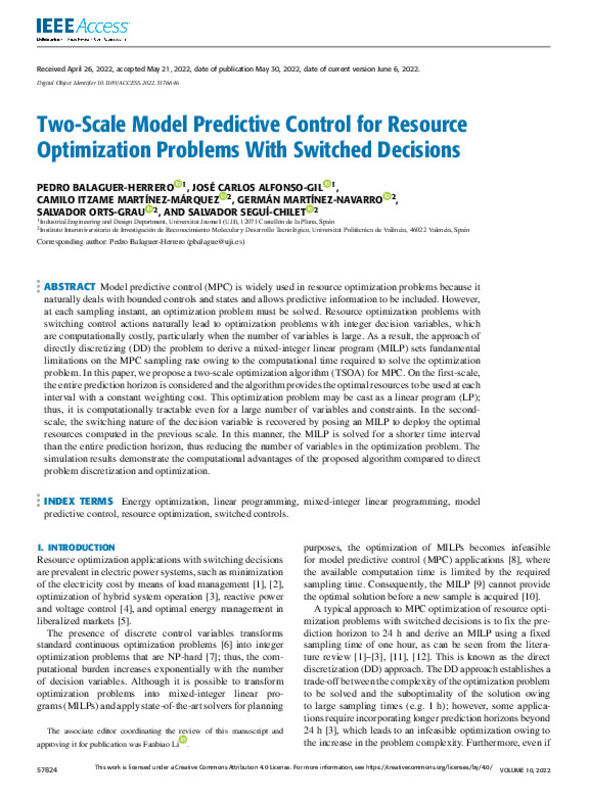JavaScript is disabled for your browser. Some features of this site may not work without it.
Buscar en RiuNet
Listar
Mi cuenta
Estadísticas
Ayuda RiuNet
Admin. UPV
Two-Scale Model Predictive Control for Resource Optimization Problems With Switched Decisions
Mostrar el registro sencillo del ítem
Ficheros en el ítem
| dc.contributor.author | Balaguer-Herrero, Pedro
|
es_ES |
| dc.contributor.author | Alfonso-Gil, José Carlos
|
es_ES |
| dc.contributor.author | Martínez-Márquez, Camilo Itzame
|
es_ES |
| dc.contributor.author | Martínez-Navarro, German
|
es_ES |
| dc.contributor.author | Orts-Grau, Salvador
|
es_ES |
| dc.contributor.author | Segui-Chilet, Salvador
|
es_ES |
| dc.date.accessioned | 2022-11-22T19:02:58Z | |
| dc.date.available | 2022-11-22T19:02:58Z | |
| dc.date.issued | 2022 | es_ES |
| dc.identifier.uri | http://hdl.handle.net/10251/190057 | |
| dc.description.abstract | [EN] Model predictive control (MPC) is widely used in resource optimization problems because it naturally deals with bounded controls and states and allows predictive information to be included. However, at each sampling instant, an optimization problem must be solved. Resource optimization problems with switching control actions naturally lead to optimization problems with integer decision variables, which are computationally costly, particularly when the number of variables is large. As a result, the approach of directly discretizing (DD) the problem to derive a mixed-integer linear program (MILP) sets fundamental limitations on the MPC sampling rate owing to the computational time required to solve the optimization problem. In this paper, we propose a two-scale optimization algorithm (TSOA) for MPC. On the first-scale, the entire prediction horizon is considered and the algorithm provides the optimal resources to be used at each interval with a constant weighting cost. This optimization problem may be cast as a linear program (LP); thus, it is computationally tractable even for a large number of variables and constraints. In the second-scale, the switching nature of the decision variable is recovered by posing an MILP to deploy the optimal resources computed in the previous scale. In this manner, the MILP is solved for a shorter time interval than the entire prediction horizon, thus reducing the number of variables in the optimization problem. The simulation results demonstrate the computational advantages of the proposed algorithm compared to direct problem discretization and optimization. | es_ES |
| dc.language | Inglés | es_ES |
| dc.publisher | Institute of Electrical and Electronics Engineers | es_ES |
| dc.relation.ispartof | IEEE Access | es_ES |
| dc.rights | Reconocimiento (by) | es_ES |
| dc.subject | Energy optimization | es_ES |
| dc.subject | Linear programming | es_ES |
| dc.subject | Mixed-integer linear programming | es_ES |
| dc.subject | Model predictive control | es_ES |
| dc.subject | Resource optimization | es_ES |
| dc.subject | Switched controls | es_ES |
| dc.subject.classification | TECNOLOGIA ELECTRONICA | es_ES |
| dc.title | Two-Scale Model Predictive Control for Resource Optimization Problems With Switched Decisions | es_ES |
| dc.type | Artículo | es_ES |
| dc.identifier.doi | 10.1109/ACCESS.2022.3178846 | es_ES |
| dc.rights.accessRights | Abierto | es_ES |
| dc.contributor.affiliation | Universitat Politècnica de València. Escuela Técnica Superior de Ingeniería del Diseño - Escola Tècnica Superior d'Enginyeria del Disseny | es_ES |
| dc.description.bibliographicCitation | Balaguer-Herrero, P.; Alfonso-Gil, JC.; Martínez-Márquez, CI.; Martínez-Navarro, G.; Orts-Grau, S.; Segui-Chilet, S. (2022). Two-Scale Model Predictive Control for Resource Optimization Problems With Switched Decisions. IEEE Access. 10:57824-57834. https://doi.org/10.1109/ACCESS.2022.3178846 | es_ES |
| dc.description.accrualMethod | S | es_ES |
| dc.relation.publisherversion | https://doi.org/10.1109/ACCESS.2022.3178846 | es_ES |
| dc.description.upvformatpinicio | 57824 | es_ES |
| dc.description.upvformatpfin | 57834 | es_ES |
| dc.type.version | info:eu-repo/semantics/publishedVersion | es_ES |
| dc.description.volume | 10 | es_ES |
| dc.identifier.eissn | 2169-3536 | es_ES |
| dc.relation.pasarela | S\476931 | es_ES |
| upv.costeAPC | 2130 | es_ES |








